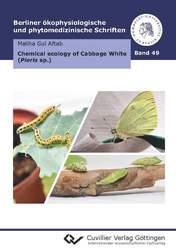| Departments | |
|---|---|
| Book Series (96) |
1378
|
| Nachhaltigkeit |
3
|
| Gesundheitswesen |
1
|
| Humanities |
2365
|
| Natural Sciences |
5406
|
| Mathematics | 229 |
| Informatics | 319 |
| Physics | 980 |
| Chemistry | 1363 |
| Geosciences | 131 |
| Human medicine | 243 |
| Stomatology | 10 |
| Veterinary medicine | 108 |
| Pharmacy | 147 |
| Biology | 835 |
| Biochemistry, molecular biology, gene technology | 121 |
| Biophysics | 25 |
| Domestic and nutritional science | 45 |
| Agricultural science | 1004 |
| Forest science | 201 |
| Horticultural science | 20 |
| Environmental research, ecology and landscape conservation | 148 |
| Engineering |
1793
|
| Common |
98
|
|
Leitlinien Unfallchirurgie
5. Auflage bestellen |
|
Advanced Search
Chemical ecology of Cabbage White (Pieris sp.) (Volume 49) (English shop)
Maliha Gul Aftab (Author)Preview
Extract, PDF (6.9 MB)
Table of Contents, PDF (110 KB)
Under the widespread concept of integrated pest management, use of semiochemicals have been extensively studied to control agricultural pest insects. In this regard, aphrodisiac pheromones of two most destructive pest species of Pieris have been investigated. Individual pheromone constituents produced in the wings of two Asian populations were compared with two European populations of P. rapae. The total pheromone levels in the European populations were lower than the amounts present in wings of Asian populations. As a result of this study, we can conclude that both the subspecies of P. rapae showed a clear variation in pheromone profile between them. On the other hand, within subspecies, the different populations did not show very large differences. Therefore, the populations with geographical difference could not be considered identical as they showed significant quantitative differences in pheromone profiles. Furthermore, Electroantennographic analysis was also carried out to find out specific pheromone lures, which could be used for both the subspecies to carried out field bioassays in future, to test the mating disruption strategy.
| ISBN-13 (Hard Copy) | 9783736974982 |
| ISBN-13 (eBook) | 9783736964983 |
| Final Book Format | A5 |
| Language | English |
| Page Number | 122 |
| Lamination of Cover | matt |
| Edition | 1. |
| Book Series | Berliner ökophysiologische und phytomedizinische Schriften |
| Volume | 49 |
| Publication Place | Göttingen |
| Place of Dissertation | Berlin |
| Publication Date | 2021-10-06 |
| General Categorization | Dissertation |
| Departments |
Agricultural science
|
| Keywords | Chemical ecology, cabbage white butterfly, Butterfly, Pieris, Schmetterling, chemische Ökologie, Kohlweißling, Schädlinge, Semiochemikalien, semiochemicals, Schadinsekte, Pheromone, pest insekts, Pheromonprofile, Pheromon-Köder, pheromone profiles, pheromone lures, Phytomedizin, natürliche Chemikalien, naturally chemicals, Kairomone, Allomone, Lepidoptera-Insekten, lepidoptera insects, Botenstoffe, messenger substances, Wirtspflanze, host plant, Wirtspflanzen-Screening, host plant screening, Flügelextrakt, Population, wings extract, Indolyl-GS-Gehalt, indolyl GS levels, Entlaubungsschäden, defoliators, Schädlingsbekämpfungsstrategien, pest management strategies, Ernteverluste, crop loss, Kreuzblütler, crucifers, Nahrungskonkurrenz, food competition, Larvenwanderung, larval migration, Pflanzenfresser, herbivore, Pflanzenschutz, Schmetterlingssterben |








